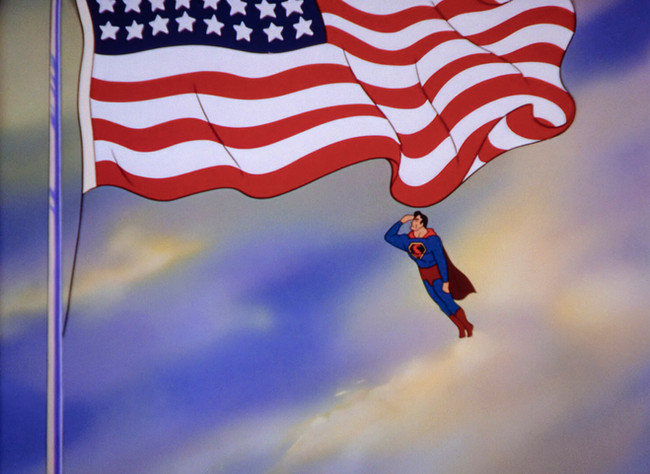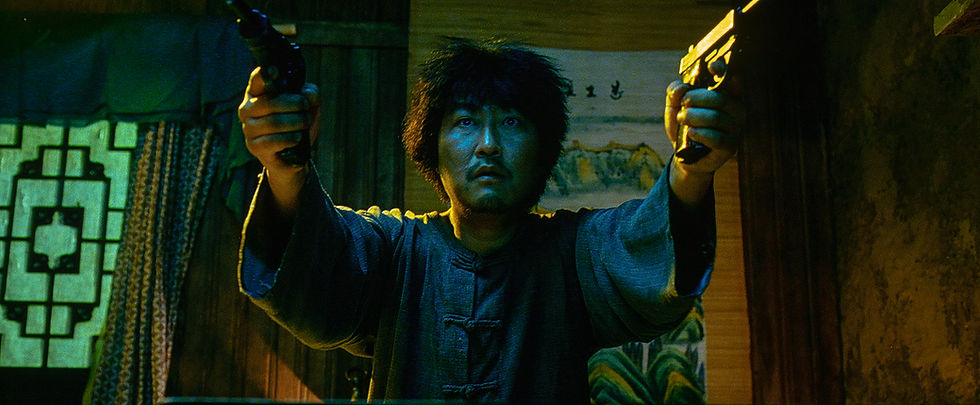Despite a misfire or two, ‘Max Fleischer’s Superman’ soars
- Craig Shapiro

- Jun 19, 2023
- 3 min read
Updated: Jun 21, 2023
BLU-RAY REVIEW / FRAME SHOTS

Superman to the rescue during the eight-minute short “Volcano,” which premiered on July 10, 1942.
(Click an image to scroll the larger versions)
“MAX FLEISCHER’S SUPERMAN”
Blu-ray, 1941-43, unrated but good for the entire fam
Best extra: The new feature, “Max Fleischer’s Superman: Speeding Toward Tomorrow”
IT SEEMS that detail, like beauty, is in the eye of the beholder. Some folks reviewing these 17 groundbreaking shorts got their panties in such a twist about this Warner Bros. Blu-ray debut that they called for skipping them. Why? Because to their “trained” eye, the studio went overboard in the Digital Noise Reduction Dept. and removed too much fine detail and grain. The shorts have apparently been compressed down to a 15-16 mpbs bit rate, too, instead of 25-30. Now, those same folks do allow that for us plebes with untrained eyes and smaller A/V set-ups, they’ll – sniff – look just fine. Gee, don’t you feel a whole lot better? Anyway, they’re right. Granted, a few of the cartoons are a tad soft, but with a 4K, 16-bit scan of the original 35mm successive exposure negative and presented in the 1.37:1 Academy aspect ratio that was common at the time, that’s a minor gripe. The Man of Steel, by and large, soars. The lush colors have never looked so vibrant or the blacks as deep.
“Superman” (Mad Scientist) - September 26, 1941
And these adventures are too cool. Superman takes on everyone and everything from mad scientists to giant robots and apes, quells earthquakes and volcanoes, and, in a sign of the times, derails the “Japoteurs” (1942). No, it doesn’t pass muster in 2023, but Pearl Harbor had been attacked nine months before and cartoons like this were intended to keep the home fires burning. Kudos for Warner for including it. The audio – original mono in lossless 2.0 DTS-HD Master Audio – is good, too. Dialogue is plenty clear and the scores by Sammy Timberg and others get a decent ride. Jerry Siegel and Joe Shuster had unveiled Superman in the pages of Action Comics only three years before he touched down in theaters. So animation legends Max Fleischer and his director brother Dave, who also brought Betty Boop and Popeye to the screen, and were Oscar-nominated for “Popeye the Sailor Meets Sinbad the Sailor” (1937), pretty much set the template. “Faster than a speeding bullet, more powerful than a locomotive, able to leap tall buildings in a single bound” was their idea. They also made the sole surviving son of Krypton fly. The Fleischers also created and pioneered the Rotoscope, which they used to project live-action footage onto a glass panel. The images were then traced frame by frame and transferred to cartoons. It’s why Superman/mild-mannered reporter Clark Kent (voiced by radio actor/announcer Bud Collyer), bulldog reporter Lois Lane (radio actor Joan Alexander) and everyone else in Supe’s orbit look so real and fluid when they move.
“Volcano” - July 10, 1942
EXTRAS Director Matt Peters (“Injustice”) and screenwriter Jeremy Adams (“Supernatural”), who just took over the “Green Lantern” comic book after a bang-up run with “The Flash,” are among those who weigh in on Superman’s history and the Fleischers’ continuing influence today (i.e., the landmark “Batman: The Animated Series”) in the fun new feature “Max Fleischer’s Superman: Speeding Toward Tomorrow.”
Superman’s strength of character, they say, was his real superpower. They also marvel at the way these stories play out with little dialogue, that Timberg set the mood with a full orchestra that played throughout the running time, and how the Fleischers are still ahead of their time: CGI is used to achieve today what they were doing in the 1940s. The other extras, both in standard def, are “First Flight: The Fleischer Superman Series,” which details the origins, history and influence of the shorts, and “The Man, the Myth, Superman,” which focuses on the character’s development on the page and screen. Until someone finally gets around to inventing the WABAC machine so we can zip back 80 years to the theaters where these seminal shorts first thrilled audiences, this collection will do nicely. – Craig Shapiro




















































We read Bill Hunt's review when he posted back in early May. And, we expected the worst, but our impressions were much better, even on our supersize laser-projected screen. Plus, we publish frame shots to show what we see on the screen, in a way to back up our claims. The first short "Superman" (Mad Scientist) has the biggest issue with film grain management, but in the other short films, the film grain is quite visible. It's not perfect, but will Warner rework the 4K master?
And a side note we agree T2 has major issues: https://www.highdefwatch.com/post/4k-flaws-aside-terminator-2-judgment-day-still-thrills
I'm sure this looks very nice. Some people love the 4K disc of Terminator 2. But if several of the so called "experts" say there are issues with this release, and you should hold off buying this disc, until the errors are fixed, I'm going to listen to the experts.
https://thedigitalbits.com/item/max-fleischers-superman-bd-2023